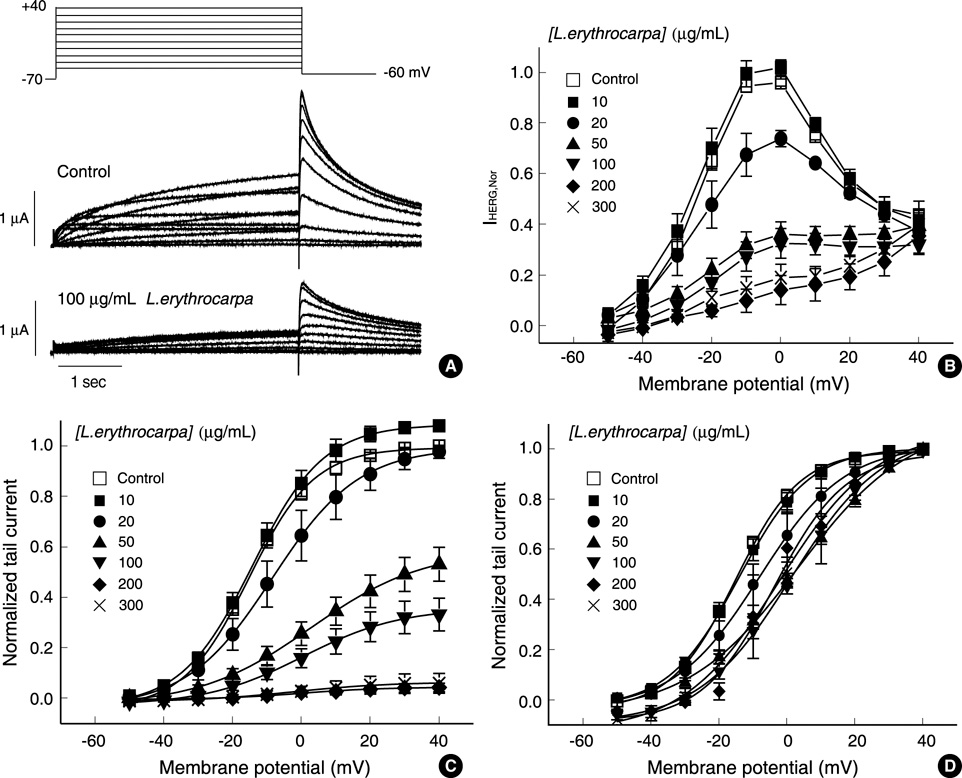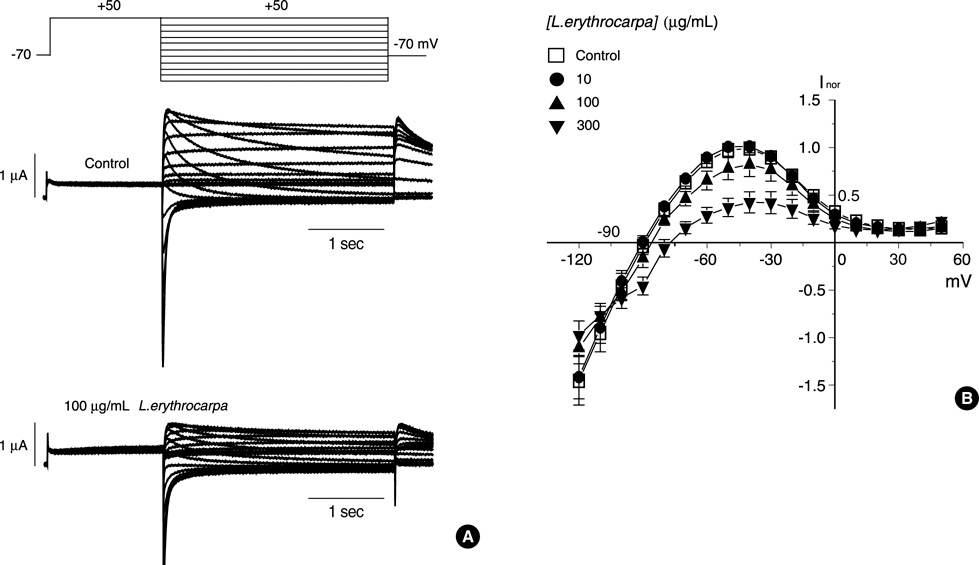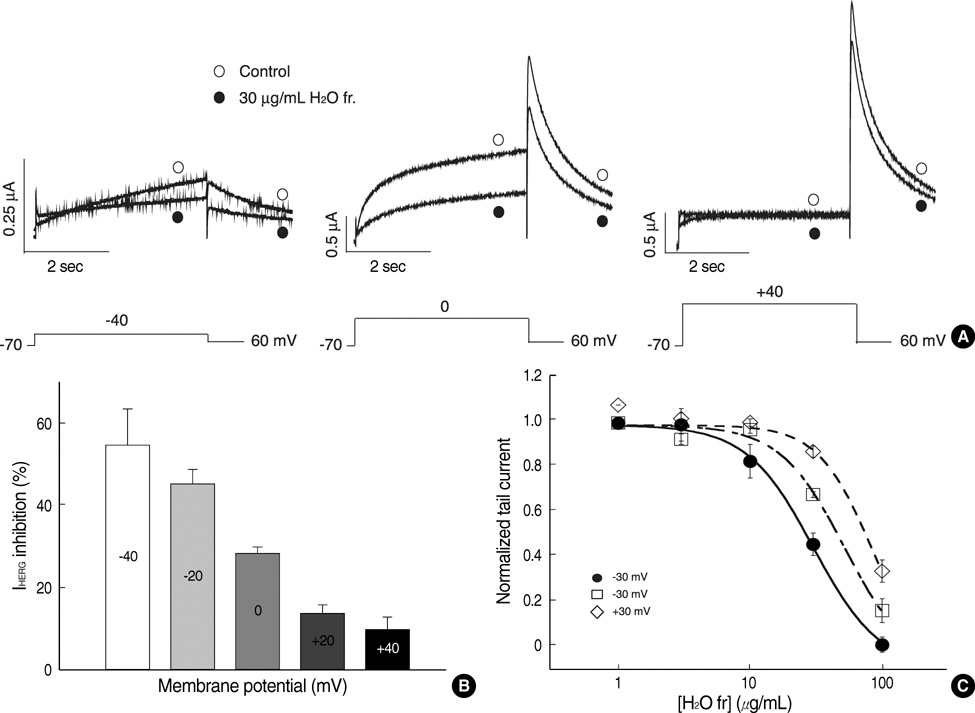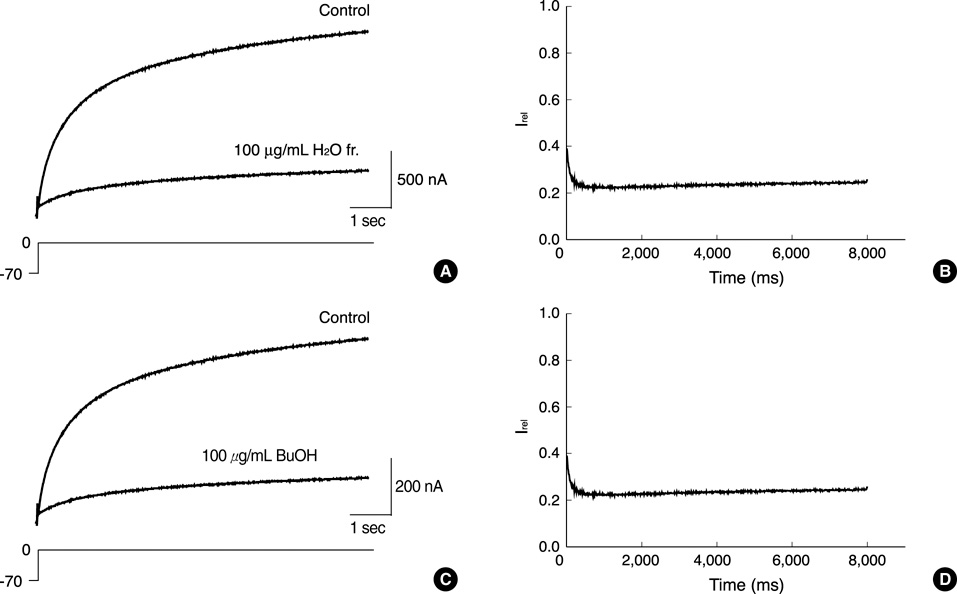J Korean Med Sci.
2009 Dec;24(6):1089-1098. 10.3346/jkms.2009.24.6.1089.
Inhibition of the Human Ether-a-go-go-related Gene (HERG) K+ Channels by Lindera erythrocarpa
- Affiliations
-
- 1Department of Physiology, Institute of Bioscience and Biotechnology, Kangwon National University College of Medicine, Chuncheon, Korea. suhyunjo@kangwon.ac.kr
- 2Department of Pharmacology, Cheju National University College of Medicine, Jeju, Korea.
- 3College of Pharmacy, Chungnam National University, Daejeon, Korea.
- KMID: 1783138
- DOI: http://doi.org/10.3346/jkms.2009.24.6.1089
Abstract
- Lindera erythrocarpa Makino (Lauraceae) is used as a traditional medicine for analgesic, antidote, and antibacterial purposes and shows anti-tumor activity. We studied the effects of Lindera erythrocarpa on the human ether-a-go-go-related gene (HERG) channel, which appears of importance in favoring cancer progression in vivo and determining cardiac action potential duration. Application of MeOH extract of Lindera erythrocarpa showed a dose-dependent decrease in the amplitudes of the outward currents measured at the end of the pulse (I(HERG)) and the tail currents of HERG (I(tail)). When the BuOH fraction and H2O fraction of Lindera erythrocarpa were added to the perfusate, both I(HERG) and I(tail) were suppressed, while the hexane fraction, CHCl3 fraction, and EtOAc fraction did not inhibit either I(HERG) or I(tail). The potential required for half-maximal activation caused by EtOAc fraction, BuOH fraction, and H2O fraction shifted significantly. The BuOH fraction and H2O fraction (100 microgram/mL) decreased gmax by 59.6% and 52.9%, respectively. The H2O fraction- and BuOH fraction-induced blockades of I(tail) progressively decreased with increasing depolarization, showing the voltage-dependent block. Our findings suggest that Lindera erythrocarpa, a traditional medicine, blocks HERG channel, which could contribute to its anticancer and cardiac arrhythmogenic effect.
MeSH Terms
Figure
Reference
-
1. Sun BY, Chung YH. Monbographic study of the Lauracea in Korea. Kor J Plant Tax. 1988. 18:133–151.2. Liu SY, Hisada S, Inagaki I. Terpenses of Lindera erythrocarpa. Phytochemistry. 1973. 12:233.3. Liu SY, Hisada S, Inagaki I. Constituents of Lindera erythrocarpa. Phytochemistry. 1973. 12:472.4. Oh HM, Choi SK, Lee JM, Lee SK, Kim HY, Han DC, Kim HM, Son KH, Kwon BM. Cyclopentenediones, inhibitors of farnesyl protein transferase and anti-tumor compounds, isolated from the fruit of Lindera erythrocarpa Makino. Bioorg Med Chem. 2005. 13:6182–6187.5. Lee SM, Baek SH, Lee CH, Lee HB, Kho YH. Cytotoxicity of Lignans from Lindera erythrocarpa Makino. Nat Prod Sci. 2002. 8:100–102.6. Sanguinetti MC, Jurkiewicz NK. Two components of cardiac delayed rectifier K+ current. Differential sensitivity to block by class III anti-arrhythmic agents. J Gen Physiol. 1990. 96:195–215.7. Spector PS, Curran ME, Zou A, Keating MT, Sanguinetti MC. Fast inactivation causes rectification of the IKr channel. J Gen Physiol. 1996. 107:611–619.
Article8. Curran ME, Splawski I, Timothy KW, Vincent GM, Green ED, Keating MT. A molecular basis for cardiac arrhythmia: HERG mutations cause long QT syndrome. Cell. 1995. 80:795–803.
Article9. Bianchi L, Wible B, Arcangeli A, Taglialatela M, Morra F, Castaldo P, Crociani O, Rosati B, Faravelli L, Olivotto M, Wanke E. Herg encodes a K+ current highly conserved in tumors of different histogenesis: a selective advantage for cancer cells? Cancer Res. 1998. 58:815–822.10. Cherubini A, Taddei GL, Crociani O, Paglierani M, Buccoliero AM, Fontana L, Noci I, Borri P, Borrani E, Giachi M, Becchetti A, Rosati B, Wanke E, Olivotto M, Arcangeli A. HERG potassium channels are more frequently expressed in human endometrial cancer as compared to non-cancerous endometrium. Br J Cancer. 2000. 83:1722–1729.
Article11. Pardo LA, del Camino D, Sánchez A, Alves F, Brüggemann A, Beckh S, Stühmer W. Oncogenic potential of EAG K(+) channels. EMBO J. 1999. 18:5540–5547.
Article12. Suzuki T, Takimoto K. Selective expression of HERG and Kv2 channels influences proliferation of uterine cancer cells. Inter J Oncol. 2004. 25:153–159.
Article13. Sanguinetti MC, Jiang C, Curran ME, Keating MT. A mechanistic link between an inherited and an acquired cardiac arrhythmia: HERG encodes the IKr potassium channel. Cell. 1995. 81:299–307.14. Kiehn J, Lacerda AE, Wible B, Brown AM. Molecular physiology and pharmacology of HERG. Single-channel currents and block by dofetilide. Circulation. 1996. 94:2572–2579.15. Thomas D, Wendt-Nordahl G, Rockl K, Ficker E, Brown AM, Kiehn J. High-affinity blockade of human ether-a-go-go-related gene human cardiac potassium channels by the novel antiarrhythmic drug BRL-32872. J Pharmacol Exp Ther. 2001. 297:753–761.16. Parihar AS, Coghlan MJ, Gopalakrishnan M, Shieh CC. Effects of intermediate-conductance Ca2+-activated K+ channel modulators on human prostate cancer cell proliferation. Eur J Pharmacol. 2003. 471:157–164.
Article17. Inglis V, Karpinski E, Benishin C. Gamma-dendrotoxin blocks large conductance Ca2+-activated K+ channels in neuroblastoma cells. Life Sci. 2003. 73:2291–2305.
Article18. Carignani C, Roncarati R, Rimini R, Terstappen GC. Pharmacological and molecular characterisation of SK3 channels in the TE671 human medulloblastoma cell line. Brain Res. 2002. 939:11–18.
Article19. Wu H, Wu K, Han Y, Shi Y, Yao L, Wang J, Fan D. Delayed rectifier K(+) channel regulated by cyclooxygenase-2 in human gastric cancer cell. Zhonghua Zhong Liu Za Zhi. 2002. 24:440–443.20. Soliven B, Ma L, Bae H, Attali B, Sobko A, Iwase T. PDGF upregulates delayed rectifier via Src family kinases and sphingosine kinase in oligodendroglial progenitors. Am J Physiol Cell Physiol. 2003. 284:C85–C93.21. Wang H, Zhang Y, Cao L, Han H, Wang J, Yang B, Nattel S, Wang Z. HERG K+ channel, a regulator of tumor cell apoptosis and proliferation. Cancer Res. 2002. 62:4843–4848.22. Cone CD Jr, Tongier M Jr. Control of somatic cell mitosis by simulated changes in the transmembrane potential level. Oncology. 1971. 25:168–182.
Article23. Rim YS, Park YM, Park MS, Kim KY, Kim MJ, Choi YH. Screening of antioxidants and antimicrobial activity in native plants. Korean J Med Crop Sci. 2000. 8:342–350.24. Suessbrich H, Schonherr R, Heinemann SH, Attali B, Lang F, Busch AE. The inhibitory effect of the antipsychotic drug haloperidol on HERG potassium channels expressed in Xenopus oocytes. Br J Pharmacol. 1997. 120:968–974.
Article25. Suessbrich H, Waldegger S, Lang F, Busch AE. Blockade of HERG channels expressed in Xenopus oocytes by the histamine receptor antagonists terfenadine and astemizole. FEBS Lett. 1996. 385:77–80.
Article26. Rampe D, Roy ML, Dennis A, Brown AM. A mechanism for the proarrhythmic effects of cisapride (Propulsid): high affinity blockade of the human cardiac potassium channel HERG. FEBS Lett. 1997. 417:28–32.
Article27. Green WN, Andersen OS. Surface charges and ion channel function. Annu Rev Physiol. 1991. 53:341–359.
Article28. Hille B. Ionic channels of excitable membranes. 1992. 2nd ed. Sunderland, Mass: Sinauer Associates Inc;459–461.29. Wang N, Minatoguchi S, Arai M, Uno Y, Hashimoto K, Xue-Hai C, Fukuda K, Akao S, Takemura G, Fujiwara H. Lindera strychnifolia is protective against post-ischemic myocardial dysfunction through scavenging hydroxyl radicals and opening the mitochondrial KATP channels in isolated rat hearts. Am J Chin Med. 2004. 32:587–598.
Article30. Su MJ, Nieh YC, Huang HW, Chen CC. Dicentrine, an alpha-adrenoceptor antagonist with sodium and potassium channel blocking activities. Naunyn-Schmiedebergs Arch Pharmacol. 1994. 349:42–49.
- Full Text Links
- Actions
-
Cited
- CITED
-
- Close
- Share
- Similar articles
-
- Acepromazine inhibits hERG potassium ion channels expressed in human embryonic kidney 293 cells
- Taxifolin Glycoside Blocks Human ether-a-go-go Related Gene K+ Channels
- Effects of Paroxetine on a Human Ether-a-go-go-related Gene (hERG) K⺠Channel Expressed in Xenopus Oocytes and on Cardiac Action Potential
- Block of hERG K+ Channel by Classic Histamine H1 Receptor Antagonist Chlorpheniramine
- Inhibitory Actions of HERG Currents by the Immunosuppressant Drug Cyclosporin A







